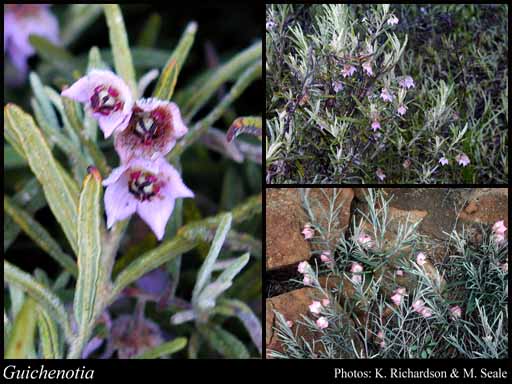- Reference
- Mém.Mus.Hist.Nat. 7:448 (1821)
- Name Status
- Current

Scientific Description
Family Sterculiaceae.
(Subfamily Byttnerioideae), Tribe Lasiopetalae.
Habit and leaf form. Shrubs; non-laticiferous and without coloured juice. ‘Normal’ plants. Leaves well developed. Plants with roots; non-succulent. Leaves cauline. To 0.5–2 m high. Self supporting. Mesophytic. Not heterophyllous. Leaves small, or medium-sized; alternate; with blades; petiolate. Petioles wingless. Leaves with ‘normal’ orientation; simple; not peltate. Leaf blades neither inverted nor twisted through 90 degrees; dorsiventral; entire; flat; linear (to narrowly so), or oblong (to narrowly so); pinnately veined; cross-venulate. Mature leaf blades adaxially becoming glabrous, or pubescent (‘densely stellate-hairy’); abaxially pubescent (‘densely stellate hairy’). Leaves with stipules. Stipules leafy; persistent. Leaf blade margins entire; revolute. Leaf anatomy. Hairs present; complex hairs present. Complex hairs stellate.
Reproductive type, pollination. Fertile flowers hermaphrodite. Unisexual flowers absent. Plants hermaphrodite. Plants homostylous.
Inflorescence and flower features. Flowers aggregated in ‘inflorescences’, or solitary (G. macrantha); not crowded at the stem bases. Inflorescence few-flowered. Flowers in racemes. Inflorescences simple, or compound (sometimes 2-branched in G. ledifolia); axillary. Flowers pedicellate; bracteate. Bracts deciduous. Flowers bracteolate; small, or medium-sized (rarely); regular; not resupinate; neither papilionaceous or pseudo-papilionaceous; 5 merous; cyclic; tetracyclic. Perianth with distinct calyx and corolla; 10; 2 -whorled; isomerous. Calyx present; 5; 1 -whorled; gamosepalous; lobed. Calyx lobes about the same length as the tube, or markedly longer than the tube. Calyx prominently 3–5 veined (or reticulate-veined in G. sarotes); hairy (densely stellate-hairy or with small stellate hairs on the veins in G. sarotes); exceeding the corolla; regular; neither appendaged nor spurred; pink, or purple, or white (G. sarotes, rarely). Calyx lobes ovate, or triangular. Corolla present; 5; 1 -whorled; not appendiculate; polypetalous; regular. Petals small and scale-like. Androecium present. Fertile stamens present. Androecial members definite in number. Androecium 5–10 (rarely). Androecial members free of the perianth; free of the gynoecium; markedly unequal; coherent (shortly connate at the base), or free of one another; 1 - adelphous (when connate); 1 -whorled. Androecium exclusively of fertile stamens, or including staminodes (more rarely). Stamens 5; all more or less similar in shape; isomerous with the perianth; filantherous. Anthers separate from one another; all alike; dehiscing via short slits; bilocular. Fertile gynoecium present. Gynoecium 5 carpelled. The pistil 5 celled. Carpels isomerous with the perianth. Gynoecium syncarpous; synovarious to eu-syncarpous; superior. Ovary plurilocular; 5 locular. Gynoecium stylate. Styles 1; simple; apical; hairy (at the base or at the base and under the stigma). Placentation axile.
Fruit and seed features. Fruit dehiscent. Dispersal unit the seed.
Geography, cytology, number of species. Native of Australia. Endemic to Australia. Australian states and territories: Western Australia. South-West Botanical Province. A genus of ca 6 species; 6 species in Western Australia; 6 endemic to Western Australia.
Additional comments. Ovary densely stellate-hairy or stellate and glandular hairy, or glandular hairy only. Stipules and leaves appearing to form whorls.
Taxonomic Literature
- Wheeler, Judy; Marchant, Neville; Lewington, Margaret; Graham, Lorraine 2002. Flora of the south west, Bunbury, Augusta, Denmark. Volume 2, dicotyledons. Australian Biological Resources Study.. Canberra..
- Grieve, B. J.; Blackall, W. E. 1998. How to know Western Australian wildflowers : a key to the flora of the extratropical regions of Western Australia. Part II, Dicotyledons (Amaranthaceae to Lythraceae). University of W.A. Press.. Nedlands, W.A..
- Marchant, N. G.; Wheeler, J. R.; Rye, B. L.; Bennett, E. M.; Lander, N. S.; Macfarlane, T. D.; Western Australian Herbarium 1987. Flora of the Perth region. Part one. Western Australian Herbarium.. [Perth]..